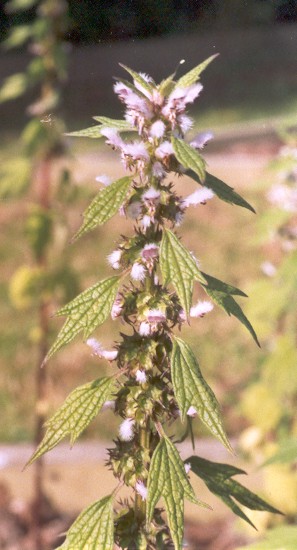Leonurus cardiaca (L)
Synonyms: lion's ear, lion's tail, Roman motherwort, throw-wort
Order: Labiatae

Description: This is an erect perennial, 60-120cm high, with prominent coarsely-toothed 5-7-lobed leaves. Whorls of white to pink flowers arise in the upper leaf axils; the calyx and later the seed case are notable for the border of prickly teeth. Leonurus grows in waste places and hedgerows throughout northern temperate regions and is common in Britain.
Parts used: aerial parts
Collection: during the flowering period, between June and September
Constituents: alkaloids (including leonurine and stachydrene), iridoid glycoside (leonuride), iridoid glycosides (including leonurin and leonuridine), diterpenoids (including leocardin), flavonoids (including rutin, quercetin, hyperoside and apigenin), volatile oil, tannins, vitamin A
Actions: sedative, nervine, antispasmodic, emmenagogue, mildly hypotensive, cardiac tonic, gentle uterine stimulant, mild stimulant to the womb, relaxant, carminative, diaphoretic
Indications: cardiac debility, simple tachycardia, effort syndrome, amenorrhoea. Specifically indicated in cardiac symptoms associated with neurosis.
Therapeutics and Pharmacology: Leonurus is an excellent heart tonic, and research has shown that it is able to calm palpitations, tachycardia and irregular heartbeats. It is a specific remedy for tachycardia caused by anxiety, and may be used in all heart conditions associated with anxiety and tension. Treatment should normally be continued for several months. The alkaloid leonurine produces central nervous depressant and hypotensive effects in animals, and stachydrine may also be involved. The glycosides have a short-term ability to lower blood pressure.
Leonurus is valuable in the stimulation of suppressed or delayed menstruation, and to ease dysmenorrhoea, especially where there is anxiety or tension involved. It may be used to ease false labour pains, and the infusion, taken after childbirth, will help restore the uterus and reduce the risk of post-partum bleeding. The alkaloids encourage and ease uterine contractions. It is also helpful during the menopause. The infusion or diluted tincture may be used as a douche for vaginal infections and discharges. Other indications include diarrhoea. In Germany the plant is used as an adjuvant in treatment of an overactive thyroid gland.
Combinations: Leonurus can be combined with Ballota for false labour pains.
Caution: Leonurus is a uterine stimulant and so should be avoided in pregnancy, although it may be used during labour. Stachydrine has the effect of hastening childbirth. Chinese research on L. heterophyllus has shown that decoctions of the plant are as effective as ergotamine in causing the uterus to contract after delivery. Contact with the plant may cause dermatitis in susceptible individuals.
Preparation and Dosage: (thrice daily)
Regulatory status GSL
Dried herb: 2-4g or by infusion
Liquid Extract: 1:1 in 25% alcohol, 2-4ml
Tincture: 1:5 in 45% alcohol, 2-6ml; 1:5 in 25% alcohol, 4-10ml
Additional Comments: An important herb since Roman times, the name Leonurus is derived from a Greek word meaning lion's tail, describing the shaggy shape of the leaves. The ancient Greeks used motherwort to relieve anxiety in new mothers. Early herbals recommend the plant for 'wykked sperytis'. Culpeper said, 'There is no better herb to drive melancholy vapours from the heart, to strengthen it and make the mind cheerful, blithe and merry. Chinese herbalists use the related species L. heterophyllus mainly for menstrual disorders, raised blood pressure, heart disease and conjunctivitis. The aerial parts (yi mu cao) are also used for eczema and sores, while the seeds (chong wei zi) are used for menstrual irregularities, and as a circulatory stimulant. They are also believed to act specifically on the liver, and are therefore especially effective on the eyes to 'brighten the vision'. A weak decoction of the seeds may be used in conjunctivitis, or sore and tired eyes.
Bibliography
BHMA 1983 British Herbal Pharmacopoeia, BHMA, Bournemouth.
Bradley, P.R. (ed.) 1992 British Herbal Compendium, Volume 1, BHMA, Bournemouth.
Culpeper, N. 1649 Complete Herbal and English Physician, 1990 reprint of the 1814 London edition of Culpeper�s Complete Herbal, Meyer, Illinois.
Grieve, M. 1931 A Modern Herbal, (ed. C.F. Leyel 1985), London.
Hoffmann, D. 1990 The New Holistic Herbal, Second Edition, Element, Shaftesbury.
Lust, J. 1990 The Herb Book, Bantam, London.
Mabey, R. (ed.) 1991 The Complete New Herbal, Penguin, London.
Mills, S.Y. 1993 The A-Z of Modern Herbalism, Diamond Books, London.
Ody, P. 1993 The Herb Society's Complete Medicinal Herbal, Dorling Kindersley, London.
Polunin, M. and Robbins, C. 1992 The Natural Pharmacy, Dorling Kindersley, London.
Weiss, R.F. 1991 Herbal Medicine, Beaconsfield Arcanum, Beaconsfield.
Wren, R.C. 1988 Potter's New Cyclopaedia of Botanical Drugs and Preparations, C.W.Daniel, Saffron Walden.










